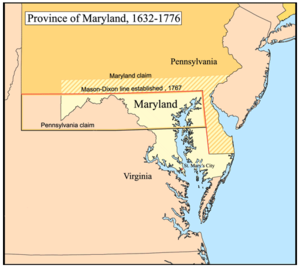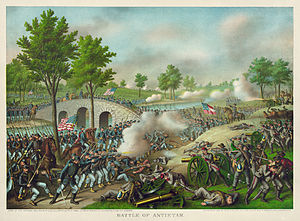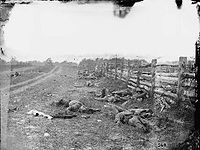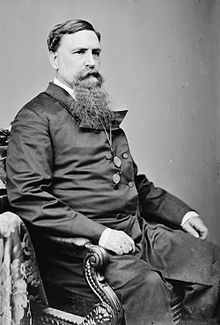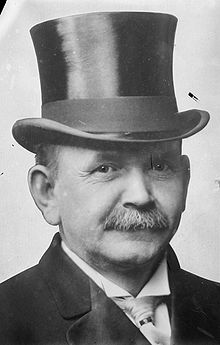- History of Maryland
-
 The flag of Maryland
The flag of Maryland
The history of Maryland included only Native Americans until Europeans, starting with John Cabot in 1498, began exploring the area. The first settlements came in 1634 when the English arrived in significant numbers and created a permanent colony. In 1776, during the American Revolution, Maryland became a state in the United States. Although it was a slave state where many planters had Confederate sympathies, by 1860 nearly half the black population was already free, due mostly to manumissions after the American Revolution.[1] Maryland remained in the Union during the American Civil War.
Although small in size, the state has distinct socio-political-economic regions, including the city of Baltimore, Baltimore's suburbs, the Washington suburbs, Western Maryland, and the Eastern Shore. Maryland has a democratic-type of state government.
Contents
Pre-colonial history
See also: Pre-Colonial AmericaIt appears that the first humans to arrive in the area that would become Maryland appeared around the 10th millennium BCE, about the time that the last ice age ended. They were hunter-gatherers organized into semi-nomadic bands. They adapted as the region's environment changed, developing the spear for hunting as smaller animals, like deer, became more prevalent and by about 1500 BCE. Oysters had become an important food resource in the region. With the increased variety of food sources, Native American villages and settlements started appearing and their social structures increased in complexity. By about 1000 BCE pottery was being produced. With the eventual rise of agriculture more permanent Native-American villages were built. But even with the advent of farming, hunting and fishing were still important means of obtaining food. The bow and arrow were first used for hunting in the area around the year 800. They ate what they could kill, grow or catch in the rivers and other waterways.
By 1000 BCE, there were about 8,000 Native Americans, all Algonquian-speaking, living in what is now the state, in 40 different villages. The following Piscataway tribes lived on the eastern bank of the Potomac, from south to north: Yaocomicoes, Chopticans, Nanjemoys, Potopacs, Mattawomans, Piscataways, Patuxents just south of what is now Washington, DC, Nacotchankes in current DC and on the western bank of the Potomac, and the Potomacs. The Shawnee lived near Oldtown in a site abandoned around 1731. On the Eastern Shore of the Chesapeake, from south to north, there were the Nanticoke tribes: Annemessex, Assateagues, Wicomicoes, Nanticokes, Chicacone, and, on the north bank of the Choptank River, the Choptanks. The Tockwogh tribe lived near the headwaters of the Chesapeake near what is now Delaware.[2]
When Europeans began to settle in Maryland in the early 17th century, the main tribes included the Nanticoke on the Eastern Shore. Early exposure to new European diseases brought widespread fatalities to the Native Americans, as they had no immunity to them. Communities were disrupted by such losses.
Early European exploration
In 1498 the first European explorers sailed along the Eastern Shore, off present-day Worcester County.[3] In 1524 Giovanni da Verrazzano, sailing under the French flag, passed the mouth of Chesapeake Bay. In 1608 John Smith entered the bay.[4]
Colonial Maryland
See also: Province of MarylandGeorge Calvert, 1st Baron Baltimore, applied to Charles I for a royal charter for what was to become the Province of Maryland. After Calvert died in April 1632, the charter for "Maryland Colony" (in Latin Terra Mariae) was granted to his son, Cecilius Calvert, 2nd Baron Baltimore, on June 20, 1632. Some historians viewed this as compensation for his father's having been stripped of his title of Secretary of State in 1625 after announcing his Roman Catholicism.
The colony was named in honor of Queen Henrietta Maria, the wife of King Charles I.[5] The specific name given in the charter was phrased Terra Mariae, anglice, Maryland. The English name was preferred due to undesired associations of Mariae with the Spanish Jesuit Juan de Mariana, linked to the Inquisition.[6]
As did other colonies, Maryland used the headright system to encourage people to bring in new settlers. Led by Leonard Calvert, Cecil Calvert's younger brother, the first settlers departed from Cowes, on the Isle of Wight, on November 22, 1633 aboard two small ships, the Ark and the Dove. Their landing on March 25, 1634 at St. Clement's Island in southern Maryland is commemorated by the state each year on that date as Maryland Day. This was the site of the first Catholic mass in the Colonies, with Father Andrew White leading the service. The first group of colonists consisted of 17 gentlemen and their wives, and about two hundred others, mostly indentured servants who could work off their passage.[citation needed]
After purchasing land from the Yaocomico Indians and establishing the town of St. Mary's, Leonard, per his brother's instructions, attempted to govern the country under feudalistic precepts. Meeting resistance, in February 1635, he summoned a colonial assembly. In 1638, the Assembly forced him to govern according to the laws of England. The right to initiate legislation passed to the assembly.
In 1638, Calvert seized a trading post in Kent Island established by the Virginian William Claiborne. In 1644, Claiborne led an uprising of Maryland Protestants. Calvert was forced to flee to Virginia, but he returned at the head of an armed force in 1646 and reasserted proprietarial rule.
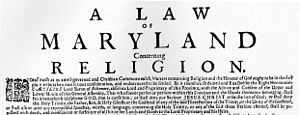 A large broadside of the Maryland Toleration Act
A large broadside of the Maryland Toleration Act
Maryland soon became one of the few predominantly Catholic regions among the English colonies in North America. Maryland was also one of the key destinations where the government sent tens of thousands of English convicts punished by sentences of transportation. Such punishment persisted until the Revolutionary War.
The Maryland Toleration Act, issued in 1649, was one of the first laws that explicitly defined tolerance of varieties of Christianity. It has been considered a precursor to the First Amendment.
The founders designed the city plan of the colonial capital, St. Mary's City, to reflect their world view. At the center of the city was the home of the mayor of St. Mary's City. From that point, streets were laid out that created two triangles. Located at two points of the triangle extending to the west were the first Maryland state house and a jail.[citation needed] Extending to the north of the mayor's home, the remaining two points of the second triangle were defined by a Catholic church and a school. The design of the city was a literal separation of church and state that reinforced the importance of religious freedom.
The largest site of the original Maryland colony, St. Mary's City was the seat of colonial government until 1708. Because Anglicanism had become the official religion in Virginia, a band of Puritans in 1642 left for Maryland; they founded Providence (now called Annapolis).[7]
In 1650, the Puritans revolted against the proprietary government. They set up a new government prohibiting both Catholicism and Anglicanism. In March 1655, the 2nd Lord Baltimore sent an army under Governor William Stone to put down this revolt. Near Annapolis, his Roman Catholic army was decisively defeated by a Puritan army in the Battle of the Severn. The Puritan revolt lasted until 1658, when the Calvert family regained control and re-enacted the Toleration Act.
The Puritan revolutionary government persecuted Maryland Catholics during its reign. Mobs burned down all the original Catholic churches of southern Maryland. In 1708, the seat of government was moved to Providence, renamed Annapolis in honor of Queen Anne. St. Mary's City is now an archaeological site, with a small tourist center.
Just as the city plan for St. Mary's City reflected the ideals of the founders, the city plan of Annapolis reflected those in power at the turn of the 18th century. The plan of Annapolis extends from two circles at the center of the city – one including the State House and the other the Anglican St. Anne's Church (now Episcopal). The plan reflected a stronger relationship between church and state, and a colonial government more closely aligned with the Protestant church.
Based on an incorrect map, the original royal charter granted Maryland the Potomac River and territory northward to the fortieth parallel. This was found to be a problem, as the northern boundary would have put Philadelphia, the major city in Pennsylvania, within Maryland. The Calvert family, which controlled Maryland, and the Penn family, which controlled Pennsylvania, decided in 1750 to engage two surveyors, Charles Mason and Jeremiah Dixon, to establish a boundary.
They surveyed what became known as the Mason–Dixon Line, which became the boundary between the two colonies. The crests of the Penn family and of the Calvert family were put at the Mason–Dixon line to mark it. Later the Mason–Dixon line was used as a boundary between free and slave states under the Missouri Compromise of 1820.
The Revolutionary period
Further information: History of the United States (1776-1789)Main article: History of Maryland in the American RevolutionMaryland did not at first favor independence from Great Britain and gave instructions to that effect to its delegates to the Continental Congress. During this initial phase of the Revolutionary period, Maryland was governed by the Assembly of Freemen, an assembly of the state's counties. The first convention lasted four days, from June 22 to June 25, 1774. All sixteen counties then existing were represented by a total of 92 members; Matthew Tilghman was elected chairman.[citation needed]
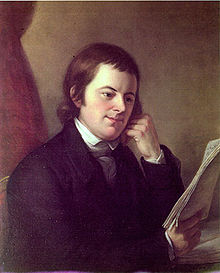 Thomas Johnson, Maryland's first elected governor under its 1776 Constitution
Thomas Johnson, Maryland's first elected governor under its 1776 Constitution
The eighth session decided that the continuation of an ad-hoc government by the convention was not a good mechanism for all the concerns of the province. A more permanent and structured government was needed. So, on July 3, 1776, they resolved that a new convention be elected that would be responsible for drawing up their first state constitution, one that did not refer to parliament or the king, but would be a government "...of the people only." After they set dates and prepared notices to the counties they adjourned. On August 1, all freemen with property elected delegates for the last convention. The ninth and last convention was also known as the Constitutional Convention of 1776. They drafted a constitution, and when they adjourned on November 11, they would not meet again. The conventions were replaced by the new state government which the Maryland Constitution of 1776 had established. Thomas Johnson became the state's first elected governor.
On March 1, 1781, the Articles of Confederation took effect with Maryland's ratification. The articles had initially been submitted to the states on November 17, 1777, but the ratification process dragged on for several years, stalled by an interstate quarrel over claims to uncolonized land in the west. Maryland was the last hold-out; it refused to ratify until Virginia and New York agreed to rescind their claims to lands in what became the Northwest Territory.
 Marylander John Hanson (circa 1765 to 1770) was the first person to serve a full term as President of the Continental Congress under the Articles of Confederation.
Marylander John Hanson (circa 1765 to 1770) was the first person to serve a full term as President of the Continental Congress under the Articles of Confederation.
No significant battles of the American Revolutionary War occurred in Maryland. However, this did not prevent the state's soldiers from distinguishing themselves through their service. General George Washington was impressed with the Maryland regulars (the "Maryland Line") who fought in the Continental Army and, according to one tradition, this led him to bestow the name "Old Line State" on Maryland.[5][8] Today, the Old Line State is one of Maryland's two official nicknames.
The state also filled other roles during the war. For instance, the Continental Congress met briefly in Baltimore from December 20, 1776, through March 4, 1777. Furthermore, a Marylander, John Hanson, served as President of the Continental Congress from 1781 to 1782. Hanson was the first person to serve a full term as President of the Congress under the Articles of Confederation.[citation needed]
From November 26, 1783, to June 3, 1784, Annapolis served as the United States capital, and the Confederation Congress met in the Maryland State House. (Annapolis was a candidate to become the new nation's permanent capital before Washington, D.C. was built). It was in the old senate chamber[5] that George Washington famously resigned his commission as commander in chief of the Continental Army on December 23, 1783. It was also there that the Treaty of Paris, which ended the Revolutionary War, was ratified by Congress on January 14, 1784.
Maryland, 1789–1849
Further information: History of the United States (1789-1849)Quasi-war with France
After the Revolution, the US Congress approved construction of six frigates to form a nucleus of what became the United States Navy. Of the first three commissioned, one was designated for construction in Baltimore's shipyards and was named USS Constellation.
Constellation became the first official US Navy ship put to sea. Almost immediately after getting underway, Constellation was ordered to the Caribbean to protect US interests against the French. Tensions had increased following the Haitian Revolution and independence in 1804, as European powers attempted to maintain control. During the Quasi-War, Constellation, under the command of Captain Thomas Truxtun, was forced into two major ship-to-ship naval battles involving the French ship L'Insurgente and the heavier frigate Vengeance. With its victories in both encounters, Constellation also achieved the first capture by an American vessel of an enemy ship (L'Insurgente). Its return to Baltimore was accompanied by joyous celebration and nationwide fame. The Constellation's incredible speed and power inspired the French to nickname her the "Yankee Racehorse".
The War of 1812
During the War of 1812 the British conducted raids against cities along Chesapeake Bay, up to and including Havre de Grace. There were also two notable battles that occurred in the state. The first was the Battle of Bladensburg, which occurred on August 24, 1814 just outside the national capital, Washington, D.C. The militiamen defending the city were routed and retreated in confusion through the streets of the city. After overrunning the confused American defenders at Bladensburg, the British took Washington, D.C. They burned and looted major public buildings (see Burning of Washington), forcing President James Madison to flee to Brookeville, Maryland.[citation needed]
 Battle of North Point Monument (dedicated 1815), ca. 1870–1875, which appears on both the flag and the seal of Baltimore, Maryland
Battle of North Point Monument (dedicated 1815), ca. 1870–1875, which appears on both the flag and the seal of Baltimore, Maryland
The British marched next to Baltimore, where they hoped to strike a knockout blow against the demoralized Americans. Baltimore was not only a busy port, but the British thought it harbored many of the privateers who were despoiling British ships. The city's defenses were under the command of Major General Samuel Smith, an officer of Maryland militia and a United States senator. Baltimore had been well fortified with excellent supplies and some 15,000 troops. Maryland militia fought a determined delaying action at the Battle of North Point, during which a Maryland militia marksman shot and killed the British commander, general Robert Ross. The battle bought enough time for Baltimore's defenses to be strengthened.
After advancing to the edge of American defenses, the British halted their advance and withdrew. With the failure of the land advance, the sea battle became irrelevant and the British retreated.
At Fort McHenry, some 1000 soldiers under the command of Major George Armistead awaited the British naval bombardment. Their defense was augmented by the sinking of a line of American merchant ships at the adjacent entrance to Baltimore Harbor in order to thwart passage of British ships. The attack began on the morning of September 13, as the British fleet of some nineteen ships began pounding the fort with rockets and mortar shells. After an initial exchange of fire, the British fleet withdrew just beyond the 1.5 miles (2.4 km) range of Fort McHenry's cannons. For the next 25 hours, they bombarded the outmanned Americans. On the morning of September 14, an oversized American flag, which had been hastily sewn for this event, still flew over Fort McHenry. The British knew that victory had eluded them. The bombardment of the fort inspired Francis Scott Key, a native of Frederick, Maryland, to write "The Star-Spangled Banner" as witness to the assault. It later became the country's national anthem.
Maryland during the Frontier Age
In 1839, the United States' first passenger railway service opened between Baltimore and nearby Ellicott City. As the railway expanded westward to Cumberland and Chicago, it competed for business with the earlier 189 miles (304 km) Chesapeake and Ohio Canal and the National Road.
The United States Naval Academy was founded in Annapolis in 1845, and the Maryland Agricultural College was chartered in 1856, growing eventually into the University of Maryland.
Maryland in the Civil War
Main article: Maryland in the American Civil WarSee also: American Civil War, Origins of the American Civil War and History of slavery in Maryland
Maryland's sympathies
Maryland was one of the border states, straddling the North and South. As in Virginia and Delaware, some planters in Maryland had freed their slaves in the twenty years after the Revolutionary War. By 1860 Maryland's free black population comprised 49.1% of the total of African Americans in the state.[1] After John Brown's raid on Harper's Ferry, Virginia (now in West Virginia), some citizens in slaveholding areas began forming local militias. Of the 1860 population of 687,000, about 60,000 men joined the Union and about 25,000 fought for the Confederacy. The political sentiments of each group generally reflected their economic interests.
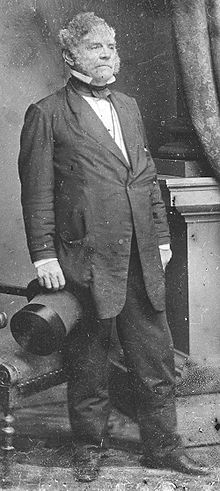 Governor Hicks
Governor Hicks
The first bloodshed of the Civil War occurred in Baltimore involving Massachusetts troops who were fired on while marching between railroad stations on April 19, 1861.[citation needed] After that, Baltimore Mayor George William Brown, Marshal George P. Kane, and former Governor Enoch Louis Lowe requested that Maryland Governor Thomas H. Hicks, a slave owner from the Eastern Shore, burn the railroad bridges and cut the telegraph lines leading to Baltimore to prevent further troops from entering the state. Hicks reportedly approved this proposal. These actions were addressed in the famous federal court case of Ex parte Merryman.
Maryland remained part of the Union during the Civil War. President Abraham Lincoln's strong hand suppressing violence and dissent in Maryland and the belated assistance of Governor Hicks played important roles. Hicks worked with federal officials to stop further violence. As an illustration of the state's sympathies, it is notable that in the 1860 election, Lincoln received only one vote in Prince George's County.
Marylanders sympathetic to the South easily crossed the Potomac River to join and fight for the Confederacy. Exiles organized a "Maryland Line" in the Army of Northern Virginia which consisted of one infantry regiment, one infantry battalion, two cavalry battalions and four battalions of artillery. According to the best extant records, up to 25,000 Marylanders went south to fight for the Confederacy. About 60,000 Maryland men served in all branches of the Union military. However, many of the Union troops were said to enlist on the promise of home garrison duty.
To prevent an uprising in Baltimore, a Union artillery garrison was placed on Federal Hill with express orders to destroy the city should Southern sympathizers overwhelm law and order there.[9] Following the Baltimore riot of 1861, Union troops under the command of General Benjamin F. Butler occupied the hill in the middle of the night. This was against Washington orders. Butler and his men erected a small fort, with cannon pointing towards the central business district. Their goal was to guarantee the allegiance of the city and the state of Maryland to the federal government under threat of force. This fort and the Union occupation persisted for the duration of the Civil War. A large flag, a few cannon, and a small Grand Army of the Republic monument remain to testify to this period of the hill's history.
Because Maryland remained in the Union, it was not included under the Emancipation Proclamation. A constitutional convention was held during 1864 that culminated in the passage of a new state constitution on November 1 of that year. Article 24 of that document outlawed the practice of slavery. The right to vote was extended to non-white males in the Maryland Constitution of 1867, which is still in effect today.
During this time the USS Constellation was flagship of the US Africa Squadron from 1859 to 1861. In this period, she disrupted the African slave trade by interdicting three slave ships and releasing the imprisoned slaves. The last of the ships was captured at the outbreak of the Civil War: Constellation overpowered the slaver brig Triton in African coastal waters. Constellation spent much of the war as a deterrent to Confederate cruisers and commerce raiders in the Mediterranean Sea.
The war on Maryland soil
The largest and most significant battle fought in the state was the Battle of Antietam, fought on September 17, 1862, near Sharpsburg. The battle was the culmination of Robert E. Lee's Maryland Campaign, which aimed to secure new supplies, recruit fresh men from among the considerable pockets of Confederate sympathies in Maryland, and to impact public opinion in the North. With those goals, Lee's Army of Northern Virginia, consisting of about 40,000 men, had entered Maryland following their recent victory at Second Bull Run.
While Major General George B. McClellan's 87,000-man Army of the Potomac was moving to intercept Lee, a Union soldier discovered a mislaid copy of the detailed battle plans of Lee's army. The order indicated that Lee had divided his army and dispersed portions geographically (to Harpers Ferry, West Virginia, and Hagerstown, Maryland), thus making each subject to isolation and defeat in detail if McClellan could move quickly enough. McClellan waited about 18 hours before deciding to take advantage of this intelligence and position his forces based on it, thus endangering a golden opportunity to defeat Lee decisively.
The armies met near the town of Sharpsburg by Antietam Creek. Although McClellan arrived in the area on September 16, his trademark caution delayed his attack on Lee, which gave the Confederates more time to prepare defensive positions and allowed Longstreet's corps to arrive from Hagerstown and Jackson's corps, minus A. P. Hill's division, to arrive from Harpers Ferry. McClellan's two-to-one advantage in the battle was almost completely nullified by a lack of coordination and concentration of Union forces, which allowed Lee to shift his defensive forces to parry each thrust.
Although a tactical draw, the Battle of Antietam was considered a strategic Union victory and a turning point of the war. It forced the end of Lee's invasion of the North. It also was enough of a victory to enable President Lincoln to issue the Emancipation Proclamation, which took effect on January 1, 1863. He had been advised by his Cabinet to make the announcement after a Union victory, to avoid any perception that it was issued out of desperation. The Union's winning the Battle of Antietam also may have dissuaded the governments of France and Great Britain from recognizing the Confederacy. Some observers believed they may have done so in the aftermath of another Union defeat.
During the war, Maryland's naval contribution, the relatively new sloop-of-war USS Constellation maintained her duty in slave ship interdiction for the Union Navy. Stationed in the Mediterranean, the Constellation actively protected convoys and defended against commerce raiders.
1865–1920
See also: History of the United States (1865–1918)Post-Civil War political developments
Since Maryland had remained in the Union during the Civil War, the state did not undergo Reconstruction like the states of the former Confederacy. However, as a former "slave state", Maryland did have issues with the civil rights of freedmen and formerly free blacks, and racial tensions, as did the states in the Confederacy. The deep divisions in the state between those who fought for the North and those who fought for the South were also difficult to reconcile.
The Democratic Party rapidly regained power in the state and replaced Republicans who had ruled during the war. Support for the Constitution of 1864 ended, and Democrats replaced it with the Maryland Constitution of 1867. That document, which is still in effect today, resembled the 1851 constitution more than its immediate predecessor and was approved by 54.1% of the state's population. Although the reapportionment of the legislature based on population, not counties, gave greater power to freedmen (as well as to urban areas), the new constitution deprived African Americans of some of the protections of the 1864 document.
Over the next several decades, the African-American population struggled in a discriminatory environment. In 1910 the legislature proposed the Digges Amendment to the state constitution. It would have used property requirements to effectively disfranchise many African Americans as well as many poor whites (including new immigrants). The Maryland General Assembly passed the bill, which Governor Austin Lane Crothers supported. Before the measure went to popular vote, a bill was proposed that would have effectively passed the requirements of the Digges Amendment into law. Not only did that measure fail (after a public outcry), but the amendment was also rejected by the voters of Maryland. This was the most notable rejection of a black-disfranchising amendment. Other similar measures were proposed, but also failed to pass (the Poe Amendment in 1905 and the Straus Amendment in 1909).
The businessmen Johns Hopkins, Enoch Pratt, George Peabody, and Henry Walters were philanthropists of 19th century Baltimore who through their generosity founded notable educational, cultural, and health care facilities in that city, bearing their names.
Progressive era reforms
See also: ProgressivismIn the early 20th century, a political reform movement arose, centered in the rising new middle class. One of their main goals included having government jobs granted on the basis of merit rather than patronage. Other changes aimed to reduce the power of political bosses and machines, which they succeeded in doing.
In a series of laws passed between 1892 and 1908, reformers worked for standard state-issued ballots (rather than those distributed and pre-marked by the parties); obtained closed voting booths to prevent party workers from "assisting" voters; initiated primary elections to keep party bosses from selecting candidates; and had candidates listed without party symbols, which discouraged the illiterate from participating. Although promoted as democratic reforms, the changes had other results sought by the middle class. They discouraged participation by the lower classes and illiterate voters. Voting participation dropped from about 82% of eligible voters in the 1890s to about 49% in the 1920s.
Other laws regulated working conditions. For instance, in a series of laws passed in 1902, the state regulated conditions in mines; outlawed child laborers under the age of 12; mandated compulsory school attendance; and enacted the nation's first workers' compensation law.[citation needed] The workers' compensation law was overturned in the courts, but was redrafted and finally enacted in 1910. The law become a model for national legislation a few decades later.[citation needed]
The debate over prohibition of alcohol, another progressive reform, led to Maryland's gaining its second nickname. A mocking newspaper editorial dubbed Maryland "the Free State" for its allowing alcohol.[5][8]
Great Baltimore Fire
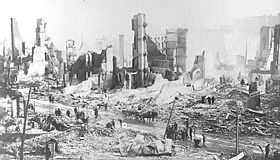 The aftermath of the Great Baltimore Fire of 1904
The aftermath of the Great Baltimore Fire of 1904
The Great Baltimore Fire of 1904 was a momentous event for Maryland's largest city and the state as a whole. The fire raged in Baltimore from 10:48 a.m. Sunday, February 7, to 5:00 p.m. Monday, February 8, 1904. More than 1,231 firefighters worked to bring the blaze under control.
One reason for the fire's duration was the lack of national standards in fire-fighting equipment. Although fire engines from nearby cities (such as Philadelphia and Washington, as well as units from New York, Wilmington, and Atlantic City) responded, many were useless because their hose couples failed to fit Baltimore hydrants. As a result, the fire burned over 30 hours, destroying 1,526 buildings and spanning 70 city blocks.
In the aftermath, 35,000 people were left unemployed. After the fire, the city was rebuilt using more fireproof materials, such as granite pavers.
The World War I era
Entry into World War I brought changes to Maryland.
Maryland was the site of new military bases, such as Camp Meade (now Fort Meade), the Aberdeen Proving Ground, which were established in 1917, and the Edgewood Arsenal, which was founded the following year. Other existing facilities, including Fort McHenry, were greatly expanded.
To coordinate wartime activities, like the expansion of federal facilities, the General Assembly set up a Council of Defense. The 126 seats on the council were filled by appointment.[clarification needed] The Council, which had a virtually unlimited budget, was charged with defending the state, supervising the draft, maintaining wage and price controls, providing housing for war-related industries, and promoting support for the war. Citizens were encouraged to grow their own victory gardens and to obey ration laws. They were also forced to work, once the legislature adopted a compulsory labor law with the support of the Council of Defense.
Maryland in the 20th century
See also: History of the United States (1918-1945)The Ritchie administration
In 1918, Maryland elected Albert C. Ritchie, a Democrat, governor. He was reelected four times, serving from 1919 to 1934, and is arguably the state's all-time most popular governor.[citation needed] Handsome and aristocratic, Ritchie was very pro-business. He hired a management firm to streamline government operations and established a budget process controlled largely by economists. He also won approval for a civil service system that had long been sought by reformers, who wanted positions given on the basis of merit and not patronage; reduced the number of state elections by extending legislative terms from two to four years; and he appointed many citizens' commissions to advise on nearly every aspect of government. State property taxes dropped sharply under Ritchie, but so did state services. A powerful state movie censorship board kept subversive ideas away from the masses. Three times, including 1924 and 1932, Ritchie was a candidate for President of the United States, arguing that Presidents Coolidge and Hoover were hopeless spendthrifts.[10] Ritchie lost his bid for the Democratic Party's nomination for President in 1932. Despite a large demonstration for support at the convention, Franklin D. Roosevelt was nominated and went on the win the election. Ritchie continued to serve as governor until 1935.[11]
The Great Depression, World War II, and aftermath
Maryland's urban and rural communities had different experiences during the Depression. In 1932 the "Bonus Army" marched through the state on its way to Washington, D.C. In addition to the nationwide New Deal reforms of President Roosevelt, which put men to work building roads and park facilities, Maryland also took steps to weather the hard times. For instance, in 1937 the state instituted its first ever income tax to generate revenue for schools and welfare.[citation needed]
The state had some advances in civil rights. The 1935 case Murray v. Pearson et al. resulted in a Baltimore City Court's ordering integration of University of Maryland Law School. The plaintiff in that case was represented by Thurgood Marshall, a young lawyer with the NAACP and a native of Baltimore. When the state attorney general appealed to the Court of Appeals, it affirmed the decision.
Because the state did not appeal the ruling in the federal courts, this state ruling under the U.S. Constitution was the first to overturn Plessy v. Ferguson, the 1896 Supreme Court decision that allowed separate but equal facilities.[citation needed] While the ruling was a moral precedent, it had no authority outside the state of Maryland.
A hurricane in 1933 created an inlet in Sinepuxent Bay at Ocean City, making the then-small town attractive for recreational fishing. During World War II additional large defense facilities were established in the state such as Andrews Air Force Base, Patuxent River Naval Air Station, and the large Glenn L. Martin aircraft factory east of Baltimore.
In 1952, the eastern and western halves of Maryland were linked for the first time by the long Chesapeake Bay Bridge, which replaced a nearby ferry service.[12] This bridge (and its later, parallel span) increased tourist traffic to Ocean City, which experienced a building boom. Soon after, the Baltimore Harbor Tunnel allowed long-distance interstate motorists to bypass downtown Baltimore, while the earlier Harry W. Nice Memorial Bridge allowed them to bypass Washington, D.C. Two beltways, I-695 and I-495, were built around Baltimore and Washington, while I-70, I-270, and later I-68 linked central Maryland with western Maryland, and I-97 linked Baltimore with Annapolis. Passenger and freight steamboat transportation, previously very important throughout the Chesapeake Bay and its many tributaries, came to an end in mid-century.
In 1980, the opening of Harborplace and the Baltimore Aquarium made that city a significant tourist destination, while Charles Center, the World Trade Center, and the popular Camden Yards baseball stadium were constructed in the downtown area. Fells Point also became popular. The historic Annapolis waterfront area, previously a working-class fishing port,[citation needed] also became gentrified[citation needed] and a tourist destination. Baltimore's largest employer, the Bethlehem Steel factory at Sparrows Point, shrunk, and the General Motors plant closed, while Johns Hopkins University and Health Care System took Bethlehem's place as Baltimore's largest employer. There are over 350 biotechnology companies in the state.[13] The Social Security - Health Care Financing Administration, Bureau of Standards, U.S. Census Bureau, National Institutes of Health, and Public Health Service have their headquarters in the state. Metrorail lines were constructed in Montgomery and Prince George's counties, while Baltimore opened its own 20 miles (32 km) Metro Subway as well as the north-south Baltimore Light Rail system.
In addition to general suburban growth, specially planned new communities sprung up, most notably Columbia, but also Montgomery Village, Belair at Bowie, St. Charles, Cross Keys, and Joppatowne, and numerous shopping malls, the states' three largest malls being Annapolis Mall, Arundel Mills and the Towson Town Center. Community colleges were established in nearly every county in Maryland. Large-scale, mechanized poultry farms became prevalent on the lower Eastern Shore, along with irrigated vegetable farming. In Southern Maryland tobacco farming had nearly vanished by the century's end, due to suburban housing development and a state tobacco incentive buy-out program. Industrial, railroad, and coal-mining jobs in the four westernmost counties declined, but that area's economy was helped by expansion of outdoor recreational tourism and new technology jobs and industries.[citation needed] As the 21st century dawned, Maryland joined neighboring states in a new initiative to save the health of Chesapeake Bay, whose aquatic life and seafood industry are threatened by waterfront residential development, as well as by fertilizer and livestock waste entering the bay, especially from Pennsylvania's Susquehanna River. In addition, about 580 acres (230 ha) of Maryland shore are eroded per year due to the land sinking and rising sea levels.[14]
See also
Main article: Historical outline of Maryland- Government of Maryland
- History of the Southern United States
- History of Washington, D.C.
- List of people from Maryland
Printed media
- Maryland State Archives (September 16, 2004).Historical Chronology.
- Whitman H. Ridgway. Maryland Humanities Council (2001). "(Maryland) Politics and Law"
- Maryland State Archives. (October 29, 2004).Maryland Manual On-Line: A Guide to Maryland Government. Retrieved June 1, 2005.
- "Maryland". The Catholic Encyclopedia. Retrieved May 22, 2005.
- "Maryland". The Jewish Encyclopedia. Retrieved May 22, 2005.
- Dennis C. Curry (2001). "Native Maryland, 9000 B.C.-1600 A.D.".
- Whitman H. Ridgway. Maryland Humanities Council (2001). "(Maryland in) the Nineteenth Century".
- George H. Callcott. Maryland Humanities Council (2001). "(Maryland in) the Twentieth Century".
References
- ^ a b Peter Kolchin, American Slavery: 1619–1877, New York: Hill and Wang, 1993, pp.81–82
- ^ Reynolds, Patrick M. (11 April 2010). "Flashback column:The Tribes of Maryland". Washington, DC: Washington Post. pp. SC9.
- ^ Maryland State Archives - Chronology 10,000 BC - 1599
- ^ Maryland State Archives - Chronology 10,000 BC - 1599
- ^ a b c d Maryland At a Glance. Retrieved on 2007-02-07.
- ^ Stewart, George R. (1967) [1945]. Names on the Land: A Historical Account of Place-Naming in the United States (Sentry edition (3rd) ed.). Houghton Mifflin. pp. 42–43.
- ^ Owen M. Taylor, History of Annapolis (1872) p 5 online
- ^ a b Montgomery, Lori (March 14, 2000). "Two-Bit Identity Crisis; Imprint Befuddles the Free—Make That 'Old Line'—State". The Washington Post. gwpapers.virginia.edu. http://gwpapers.virginia.edu/articles/news/mdquarter.html. Retrieved October 7, 2009.
- ^ see Federal Hill, Baltimore
- ^ Joseph B. Chepaitis, "Albert C. Ritchie in Power: 1920–1927". Maryland Historical Magazine (1973) 68(4): 383-404
- ^ Dorothy Brown, "The Election of 1934: the 'New Deal' in Maryland," Maryland Historical Magazine (1973) 68(4): 405-421
- ^ "William Preston Lane Jr. Memorial Bay Bridge - History". baybridge.com. http://www.baybridge.com/cms/index.php?option=com_content&task=view&id=16&Itemid=. Retrieved 2008-02-05.
- ^ "Business in Maryland: Biosciences". Maryland Department of Business & Economic Development. Archived from the original on September 30, 2007. http://web.archive.org/web/20070930190416/http://choosemaryland.com/businessinmd/Biosciences/bio.html. Retrieved 2007-10-15.
- ^ David A. Fahrenthold (2010-10-25). "Losing Battle Against the Bay". Washington Post. Washington Post. http://www.washingtonpost.com/wp-dyn/content/article/2010/10/24/AR2010102403208.html.
Further reading
Surveys
- Brugger, Robert J. Maryland, A Middle Temperament: 1634–1980 (1996) full scale history
- Chappelle, Suzanne. Jean H. Baker, Dean R. Esslinger, and Whitman H. Ridgeway. Maryland: A History of its People (1986)
Colonial to 1860
- Arson, Steven, “Yeoman Farmers in a Planters’ Republic: Socioeconomic Conditions and Relations in Early National Prince George’s County, Maryland,” Journal of the Early Republic, 29 (Spring 2009), 63–99.
- Brackett; Jeffrey R. The Negro in Maryland: A Study of the Institution of Slavery (1969) online edition
- Browne, Gary Lawson. Baltimore in the Nation, 1789–1861 (1980)
- Carr, Lois Green, Philip D. Morgan, Jean Burrell Russo, eds. Colonial Chesapeake Society (1991)
- Craven, Avery. Soil Exhaustion as a Factor in the Agricultural History of Virginia and Maryland, 1606–1860 (1925; reprinted 2006)
- Fields, Barbara. Slavery and Freedom on the Middle Ground: Maryland During the Nineteenth Century (1987)
- Hoffman, Ronald. Princes of Ireland, Planters of Maryland: A Carroll Saga, 1500–1782 (2000) 429pp ISBN 0-8078-2556-5.
- Hoffman, Ronald. A Spirit of Dissension: Economics, Politics, and the Revolution in Maryland (1973)
- Kulikoff, Allan. Tobacco and Slaves: The Development of Southern Cultures in the Chesapeake, 1680–1800 (1988)
- Middleton, Arthur Pierce. Tobacco Coast: A Maritime History of Chesapeake Bay in the Colonial Era (1984) online edition
- Risjord; Norman K. Chesapeake Politics, 1781–1800 (1978) online edition
- Steiner; Bernard C. Maryland under the Commonwealth: A Chronicle of the Years 1649–1658 1911
- Tate, Thad W. ed. The Chesapeake in the seventeenth century: Essays on Anglo-American society (1979), scholarly studies
Since 1860
- Anderson, Alan D. The Origin and Resolution of an Urban Crisis: Baltimore, 1890–1930 (1977)
- Argersinger, Jo Ann E. Toward a New Deal in Baltimore: People and Government in the Great Depression (1988)
- Durr, Kenneth D. Behind the Backlash: White Working-Class Politics in Baltimore, 1940–1980 University of North Carolina Press, 2003 online edition
- Ellis; John Tracy The Life of James Cardinal Gibbons: Archbishop of Baltimore, 1834–1921 2 vol 1952 online edition v.1; online ed. v.2
- Fein, Isaac M. The Making of an American Jewish Community: The History of Baltimore Jewry from 1773 to 1920 1971 online edition
- Wennersten, John R. Maryland's Eastern Shore: A Journey in Time and Place (1992)
Primary sources
See also: List of newspapers in Maryland in the 18th-century- Clayton Colman Hall, ed. Narratives of Early Maryland, 1633–1684 (1910) 460 pp. online edition
- David Hein, editor. Religion and Politics in Maryland on the Eve of the Civil War: The Letters of W. Wilkins Davis. 1988; revised ed., Eugene, OR: Wipf & Stock, 2009.
External links
- Maryland Historical Society
- Maryland Military Historical Society
- Maryland Archives
 "Maryland". Catholic Encyclopedia. New York: Robert Appleton Company. 1913.
"Maryland". Catholic Encyclopedia. New York: Robert Appleton Company. 1913.
History of the United States by political division States - Alabama
- Alaska
- Arizona
- Arkansas
- California
- Colorado
- Connecticut
- Delaware
- Florida
- Georgia
- Hawaii
- Idaho
- Illinois
- Indiana
- Iowa
- Kansas
- Kentucky
- Louisiana
- Maine
- Maryland
- Massachusetts
- Michigan
- Minnesota
- Mississippi
- Missouri
- Montana
- Nebraska
- Nevada
- New Hampshire
- New Jersey
- New Mexico
- New York
- North Carolina
- North Dakota
- Ohio
- Oklahoma
- Oregon
- Pennsylvania
- Rhode Island
- South Carolina
- South Dakota
- Tennessee
- Texas
- Utah
- Vermont
- Virginia
- Washington
- West Virginia
- Wisconsin
- Wyoming
Federal district Insular areas - American Samoa
- Guam
- Northern Mariana Islands
- Puerto Rico
- U.S. Virgin Islands
Outlying islands - Bajo Nuevo Bank
- Baker Island
- Howland Island
- Jarvis Island
- Johnston Atoll
- Kingman Reef
- Midway Atoll
- Navassa Island
- Palmyra Atoll
- Serranilla Bank
- Wake Island
Categories:- History of Maryland
- History of the Southern United States by state
- History of the United States by state
Wikimedia Foundation. 2010.

